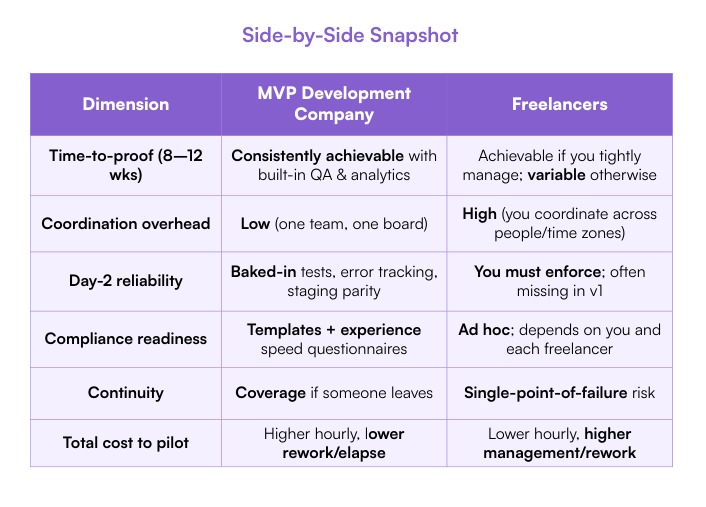1) Introduction: The Decision You Make Before You Write a Line of Code
Your first version often called an MVP -is a learning tool. Its purpose is to prove a few essential outcomes with real users and give you the confidence to invest in the right features. Before you code, you must choose the team that will help you learn quickly without creating problems you can’t fix later. For most founders, the real question is: Do I want to buy a ready-made loop (discovery → design → build → measure) or assemble and manage that loop myself?
Hiring an MVP development company gives you a cross-functional team that already works together: product, UX, engineering, QA, and DevOps. You get weekly demos, one shared backlog, and a cadence built for quick decisions. Hiring freelancers can work well, too—especially for targeted pieces of work or when you already have strong product leadership in-house. But it shifts ownership of planning, coordination, and quality control to you.
This article compares both paths in practical terms: how each affects time-to-proof, total cost, quality on “day-2” (after the demo), security and compliance expectations, and long-term ownership. You’ll also get hiring signals, workable hybrid options, and a clear way to decide. Our goal is simple: help you reach signed pilots and revenue faster—without painting yourself into a corner.
2) What You’re Actually Buying: Evidence, Not Just Engineering

Early on, your startup needs evidence more than it needs a long feature list. Three questions matter most:
- Can first-time users complete the core task without help?
- Do enough users reach activation quickly to justify further spend?
- Will the codebase survive v2 (more features, integrations, and usage) without a rewrite?
An MVP development company usually brings a complete learning loop:
- Discovery that trims scope to the smallest set of flows that prove value.
- UX research and a clickable prototype tested with real users.
- Engineering with CI/CD, basic observability, and a path to scale.
- QA sized for v1: happy-path checks and a short regression routine.
- Analytics wired from day one to track activation and task completion.
- Post-launch plan for 60–90 days: events to refine, experiments to try, and debt to address.
Freelancers can deliver these pieces, too. The difference is who owns the loop. With freelancers, you assemble the team, set acceptance criteria, run the board, and keep quality consistent. If you enjoy that role—and you have time—it can be a smart use of budget. If you want to focus on sales, fundraising, and customer interviews, a company often gets you to proof faster with fewer surprises.
The key is to buy measurable outcomes. Whether you choose a company or freelancers, insist on a single north-star metric (activation, task completion, or conversion) and weekly demos that show how the work moves that number.
3) MVP Development Company: Strengths, Weaknesses, Best Fit

Strengths
- Built-in coordination: Product, UX, engineering, QA, and DevOps already share habits and standards. Handoffs are smooth; ambiguity gets resolved quickly.
- Predictable rhythm: Discovery → prototype → working slice → MVP v1, with weekly demos and clear acceptance criteria.
- Quality guardrails from day one: Code reviews, CI/CD, happy-path tests, error tracking, and staging that mirrors production.
- Continuity and coverage: If someone is out, another teammate steps in. Less single-point-of-failure risk.
- Security and compliance awareness: Familiarity with HIPAA/PIPEDA in healthcare, SOC 2-style practices, and privacy expectations helps pass questionnaires and unlock pilots.
- Easier vendor management: One agreement, one invoice, one delivery manager.
Weaknesses
- Higher visible hourly rates: You’ll see a bigger number on paper, even if total elapsed time is lower.
- Process you might not need: If you already have a strong in-house product lead, some ceremonies can feel heavy.
- “Boring tech” bias: Good companies prefer reliable, well-supported stacks. If you want experimental tools, expect pushback.
Best Fit
- You want a working prototype/test version in 8–12 weeks with analytics and QA.
- You sell to risk-averse or regulated customers and need a credible security story.
- You want one team to ship, measure, and leave you with a clear v2 plan and docs.
4) Freelancers: Strengths, Weaknesses, Best Fit
Strengths
- Targeted spend: Pay only for roles you need, when you need them.
- Flexibility: Scale up or down quickly; swap skills as scope shifts.
- Access to specialists: Ideal for niche tasks (a specific integration, data visualization, or AI feature).
- Founder-driven pace: If you manage tightly, you can move very fast.
Weaknesses
- You run the project: Backlog, acceptance criteria, QA, releases, and documentation are your responsibility.
- Coordination overhead: Mixed time zones, different habits, variable quality; delays multiply.
- Continuity risk: If a freelancer leaves, knowledge leaves with them unless you’ve enforced documentation.
- Security and compliance gaps: You must specify controls and assemble the security summary customers expect.
- Inconsistent standards: Without a shared Definition of Done, quality drifts.
Best Fit
- You (or a co-founder) can own product management and technical choices.
- Scope is narrow and well-understood (dashboard, integration, or a vertical slice).
- Budget is tight, and you’re comfortable trading your time for cost savings.
5) Cost, Speed, and Risk—Side-by-Side Comparisons
Cost:
An MVP development company often has higher hourly rates, but fewer stalls and less rework. Freelancers look cheaper, yet total cost rises if you spend hours coordinating, rewriting, or replacing people mid-stream. The cheapest hour can become the most expensive month.
Speed:
Companies compress decision cycles with shared time zones and established habits. A focused loop ships a usable MVP in 8–12 weeks routinely. Freelancers can be just as fast when a founder runs a tight board; they can also slip if meetings, reviews, and answers wait a day or more.
Risk:
Companies reduce risks you can’t easily see in a demo: missing analytics, absent tests, broken environments, or unclear ownership. Freelancers require you to define those guardrails. If you do, risk can be low; if you don’t, you’ll feel it after launch.

6) Quality & Maintainability: Why “Day-2” Matters More Than “Demo Day”
A great demo can hide weak foundations. Day-2 is where truth shows up: a few new customers, an integration request, a spike in usage, and a bug that only appears in production.
What protects Day-2:
- Modern, well-supported stack: React/Next.js, Node/Python/.NET, Postgres, managed cloud. It’s easy to hire for and easy to maintain.
- Observability from week one: Structured logs, error tracking, simple latency dashboards for the core endpoint.
- QA sized for v1: A small set of happy-path automated checks and a short manual sweep (≤20 steps) before each release.
- Staging parity: Staging mirrors production settings as closely as possible.
- Docs and runbooks: Short setup notes, a data-flow diagram, and clear acceptance criteria.
An MVP development company usually bakes these in. With freelancers, you can get the same result, but you must require it: write a Definition of Done that includes events, tests, error tracking, and docs. If you enforce these basics, you’ll learn fast without fear and avoid expensive rewrites.
7) Security, Compliance, and IP Ownership (Don’t Skip This)
Security & Privacy basics for MVP:
- Role-based access; principle of least privilege
- Secrets management (no keys in code or chat)
- Encryption in transit and at rest
- Access logs and a minimal audit trail for key actions
- A short incident response outline (who does what, and how fast)
Compliance expectations in North America:
If you sell into healthcare, finance, public sector, or larger enterprises, expect questions about HIPAA, PIPEDA, SOC 2-style controls, and CCPA/CPRA. At MVP stage, buyers don’t expect certificates, but they do expect competence. A two-page Security & Privacy Overview plus a data-flow diagram answers most questionnaires and keeps pilots moving.
IP Ownership:
Protect your long-term control with clear contract terms:
- You own the code and all work product upon payment.
- Contributors assign rights to you (including subcontractors).
- Third-party licenses are documented; your code uses permissive licenses where relevant.
- No reuse of your proprietary code elsewhere.
Companies typically have these terms standard. With freelancers, include them explicitly and make sure everyone signs.
8) Hiring Signals: How to Spot the Real Deal (Company vs Freelancers)
MVP Development Company — Green Flags
- Starts with a short discovery and refuses to skip it.
- Commits to weekly demos and grants repo/board access.
- Shares a sample Security & Privacy Overview and a data-flow template.
- References talk about outcomes (time to MVP, pilots signed, measurable improvements).
- Prefers a boring, reliable stack and explains why.
MVP Development Company — Red Flags
- Promises “everything in two months” with no discovery.
- No QA or analytics plan in the proposal.
- Private backlog; demos only at the end.
Freelancers — Green Flags
- Portfolio shows shipped products, not just concept designs or toy repos.
- Asks for acceptance criteria and a north-star metric.
- Comfortable with code reviews, a test checklist, and staging setups.
- Will write a one-page security summary and basic runbook.
Freelancers — Red Flags
- Avoids documentation; relies on long chat threads.
- Pushes trendy stacks without solid reasons.
- Unclear availability; slow replies across time zones.
- Refuses repo access for your other contractors.
9) Hybrid Models That Work (and the ones that don’t)
Hybrid patterns that work
- Company core + specialist freelancer(s): The company owns the loop (backlog, QA, releases). A freelancer handles a specific integration, data viz, or a small AI feature. Ownership is clear; quality stays consistent.
- Your PM + a tight freelancer squad: If you’re an experienced product owner, you can run 2–3 freelancers with a strict Definition of Done and weekly demos. Keep the team small, time zones overlapping, and responsibilities clear.
Patterns that usually fail
- Many freelancers, no single owner: Decisions stall, standards drift, and the result is fragile.
- Split ownership: Company handles “hard parts,” freelancers “the rest,” but no shared board or uniform acceptance criteria. Gaps appear and nobody feels accountable.
- Zero overlap in working hours: Every question takes a day; momentum fades.
Make hybrid work with three rules
- One owner of the loop: One party controls the backlog, QA, and releases.
- Uniform standards: Same Definition of Done, same code review rules, same release checklist.
- Shared visibility: One board, one demo rhythm, one place for docs.
10) Conclusion + Next Steps
Choosing between an MVP development company and freelancers comes down to how you want to reach proof:
- If you want an integrated loop that trims scope, ships a working prototype/test version in 8–12 weeks, measures real usage, and stands up to day-2 demands, an MVP development company is the safer and faster path.
- If you already have strong product leadership, a narrow scope, and time to manage coordination and quality, freelancers can be cost-effective and fast—provided you enforce standards and keep weekly visibility.
Whichever path you choose, protect your timeline and budget by:
- Limiting v1 to 1–3 essential flows and basic admin.
- Setting a single north-star metric and reviewing it weekly.
- Requiring weekly demos, repo/board access, and a clear Definition of Done (events + tests + error tracking + docs).
- Keeping a visible debt list and a simple 90-day plan for post-launch improvements.
Next steps with Cabot
- Book a 30-minute discovery call to sanity-check scope and timeline.
- Request a 2-week pilot: clickable prototype or working slice, plus a short read-out on findings, risks, and the clearest path to a signed pilot.
Choose the team that shows you—early and often—how each week moves the number that matters. That’s how you turn a promising idea into a product customers choose and pay for.

